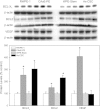Aberrant microRNA expression likely controls RAS oncogene activation during malignant transformation of human prostate epithelial and stem cells by arsenic
- PMID: 24431212
- PMCID: PMC3968309
- DOI: 10.1093/toxsci/kfu002
Aberrant microRNA expression likely controls RAS oncogene activation during malignant transformation of human prostate epithelial and stem cells by arsenic
Abstract
Inorganic arsenic (iAs), a human carcinogen, potentially targets the prostate. iAs malignantly transforms the RWPE-1 human prostate epithelial line to CAsE-PE cells, and a derivative normal stem cell (SC) line, WPE-stem, to As-Cancer SC (As-CSC) line. MicroRNAs (miRNA) are noncoding but exert negative control on expression by degradation or translational repression of target mRNAs. Aberrant miRNA expression is important in carcinogenesis. A miRNA array of CAsE-PE and As-CSC revealed common altered expression in both for pathways concerning oncogenesis, miRNA biogenesis, cell signaling, proliferation, and tumor metastasis and invasion. The KRAS oncogene is overexpressed in CAsE-PE cells but not by mutation or promoter hypomethylation, and is intensely overexpressed in As-CSC cells. In both transformants, decreased miRNAs targeting KRAS and RAS superfamily members occurred. Reduced miR-134, miR-373, miR-155, miR-138, miR-205, miR-181d, miR-181c, and let-7 in CAsE-PE cells correlated with increased target RAS oncogenes, RAN, RAB27A, RAB22A mRNAs, and KRAS protein. Reduced miR-143, miR-34c-5p, and miR-205 in As-CSC correlated with increased target RAN mRNA, and KRAS, NRAS, and RRAS proteins. The RAS/ERK and PI3K/PTEN/AKT pathways control cell survival, differentiation, and proliferation, and when dysregulated promote a cancer phenotype. iAs transformation increased expression of activated ERK kinase in both transformants and altered components of the PI3K/PTEN/AKT pathway including decreased PTEN and increases in BCL2, BCL-XL, and VEGF in the absence of AKT activation. Thus, dysregulated miRNA expression may be linked to RAS activation in both transformants.
Keywords: KRAS; arsenic; cancer; microRNA; prostate cells; stem/progenitor cells.
Figures





Similar articles
-
Silencing KRAS overexpression in arsenic-transformed prostate epithelial and stem cells partially mitigates malignant phenotype.Toxicol Sci. 2014 Dec;142(2):489-96. doi: 10.1093/toxsci/kfu201. Epub 2014 Sep 30. Toxicol Sci. 2014. PMID: 25273566 Free PMC article.
-
Molecular events associated with arsenic-induced malignant transformation of human prostatic epithelial cells: aberrant genomic DNA methylation and K-ras oncogene activation.Toxicol Appl Pharmacol. 2005 Aug 15;206(3):288-98. doi: 10.1016/j.taap.2004.11.017. Epub 2005 Jan 18. Toxicol Appl Pharmacol. 2005. PMID: 16039940
-
Arsenic Alters Exosome Quantity and Cargo to Mediate Stem Cell Recruitment Into a Cancer Stem Cell-Like Phenotype.Toxicol Sci. 2018 Sep 1;165(1):40-49. doi: 10.1093/toxsci/kfy176. Toxicol Sci. 2018. PMID: 30169766 Free PMC article.
-
The RAS oncogene in brain tumors and the involvement of let-7 microRNA.Mol Biol Rep. 2024 Apr 18;51(1):531. doi: 10.1007/s11033-024-09439-z. Mol Biol Rep. 2024. PMID: 38637419 Free PMC article. Review.
-
MicroRNA-mediated regulation of KRAS in cancer.J Hematol Oncol. 2014 Nov 30;7:84. doi: 10.1186/s13045-014-0084-2. J Hematol Oncol. 2014. PMID: 25433809 Free PMC article. Review.
Cited by
-
Chronic inorganic arsenic exposure in vitro induces a cancer cell phenotype in human peripheral lung epithelial cells.Toxicol Appl Pharmacol. 2015 Jul 1;286(1):36-43. doi: 10.1016/j.taap.2015.03.014. Epub 2015 Mar 21. Toxicol Appl Pharmacol. 2015. PMID: 25804888 Free PMC article.
-
Regulation of cytochrome P450 expression by microRNAs and long noncoding RNAs: Epigenetic mechanisms in environmental toxicology and carcinogenesis.J Environ Sci Health C Environ Carcinog Ecotoxicol Rev. 2019;37(3):180-214. doi: 10.1080/10590501.2019.1639481. Epub 2019 Jul 15. J Environ Sci Health C Environ Carcinog Ecotoxicol Rev. 2019. PMID: 31305208 Free PMC article.
-
Endocrine-disrupting chemicals as prostate carcinogens.Nat Rev Urol. 2025 Sep;22(9):609-631. doi: 10.1038/s41585-025-01031-9. Epub 2025 May 16. Nat Rev Urol. 2025. PMID: 40379948 Review.
-
Arsenic-induced prostate cancer: an enigma.Med Oncol. 2024 Jan 6;41(2):50. doi: 10.1007/s12032-023-02266-5. Med Oncol. 2024. PMID: 38184511 Review.
-
Involment of RAS/ERK1/2 signaling and MEF2C in miR-155-3p inhibition-triggered cardiomyocyte differentiation of embryonic stem cell.Oncotarget. 2017 Sep 23;8(48):84403-84416. doi: 10.18632/oncotarget.21218. eCollection 2017 Oct 13. Oncotarget. 2017. PMID: 29137434 Free PMC article.
References
-
- Achanzar W. E., Brambila E. M., Diwan B. A., Webber M. M., Waalkes M. P. Inorganic arsenite-induced malignant transformation of human prostate epithelial cells. J. Natl. Cancer Inst. 2002;94:1888–1891. - PubMed
-
- Bartel D. P. MicroRNAs: Genomics, biogenesis, mechanism, and function. Cell. 2004;116:281–297. - PubMed
-
- Beck B., Driessens G., Goossens S., Youssef K. K., Kuchnio A., Caauwe A., Sotiropoulou P. A., Loges S., Lapouge G., Candi A., et al. A vascular niche and a VEGF-Nrp1 loop regulate the initiation and stemness of skin tumours. Nature. 2011;478:399–403. - PubMed
-
- Bello D., Webber M. M., Kleinman H. K., Wartinger D. D., Rhim J. S. Androgen responsive adult human prostatic epithelial cell lines immortalized by human papillomavirus 18. Carcinogenesis. 1997;18:1215–1223. - PubMed
Publication types
MeSH terms
Substances
LinkOut - more resources
Full Text Sources
Other Literature Sources
Research Materials
Miscellaneous

